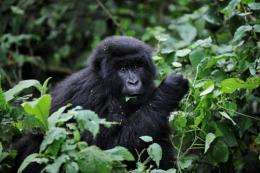Dozens of primate species on the brink: study

Seldom seen species of lemur, monkey and gorilla are among 25 primates facing near-certain extinction unless urgent measures are taken to protect them, according to a report released Thursday.
All told, close to half of the planet's 634 known primate species are to some degree threatened with dying out, said the International Union for the Conservation of Nature (IUCN) and other conservation and research groups.
That percentage has risen quickly -- only three years ago the IUCN put the ratio of vulnerable primates at one third.
"Primates are among the most endangered of all vertebrate groups," said Russell Mittermeier, head of the IUCN's primate specialist group.
Of the top 25, five are on the island of Madagascar, six on the African continent, three in South America and 11 in Southeast Asia.
The least likely to survive might well be the golden-headed langur of Vietnam, found exclusively on the island of Cat Ba in the Gulf of Tonkin. Only 60 to 70 individuals remain.
Two other species hover in number at around 100: the northern sportive lemur of Madagascar, and the eastern black crested gibbon of northern Vietnam.
Human encroachment has reduced the population of cross river gorillas, found in the mountains along the Cameroon-Nigeria border, to less than 300.
The most threatened species are not always the rarest, experts point out.
How well governments protect dwindling animal populations against deforestation and hunting is at least as critical.
More than 6,000 Sumatran orangutans, for example, are thought to survive on Indonesia's largest island. But poor enforcement of conservation measures has led to plummeting numbers and an unenviable place on the list of most critically endangered primates.
By contrast, the Hainan gibbon -- named for the Chinese island where they are found -- "is actually the world's rarest primate," said Simon Stuart, head of the IUCN's Species Survival Commission.
"But the Chinese government has some very strict conservation measures, so it is not on the list because there is not much more that can be done," he said in a phone interview.
Even so, he added, "it is one thing to stop a species from going extinct, and it is another thing to talk about recovery."
Globally, habitat destruction, especially through the burning and clearing of tropical forests for agriculture, has been the main driver toward extinction.
But in Southeast Asia, hunting for food and traditional medicines made from animal parts -- fueled by an illegal trade in wildlife -- is an even greater threat.
"It comes out again and again from all our studies, tropical Asia is by far the worst place to be for any animal bigger than a rabbit," said Stuart.
The situation in Vietnam and Laos, he added, is "particularly desperate."
Researchers hope the 'top 25' list will garner public and government support for urgently needed conservation measures, especially ahead of the next meeting of the UN's Convention on Biological Diversity, set for October in Nagoya, Japan.
"We have the resources to address this crisis, but so far, we have failed to act," said Mittermeier.
(c) 2010 AFP
















